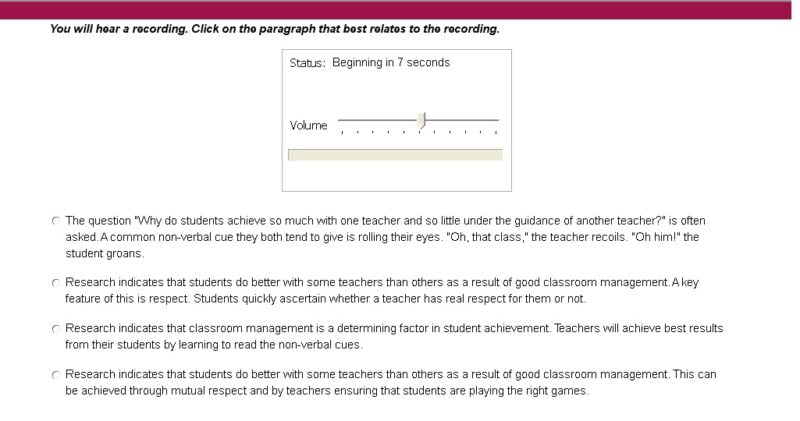
The Pearson Test of English Academic (PTE Academic) is a widely accepted test for evaluating English proficiency for academic and immigration purposes. Among its various sections, the Listening section is one of the most challenging as it assesses a combination of skills, including comprehension, attention to detail, and note-taking.
One of the question types in the Listening section is Highlight Correct Summary, which tests your ability to understand the main idea and supporting details of a spoken text. In this blog, we’ll delve deep into the format, strategies, and tips to excel at this task.
What Are Highlight Correct Summary Questions?
In this question type, you listen to a short audio recording and are presented with a list of summaries. Your task is to choose the summary that most accurately reflects the main idea and key details of the recording.
Key Features of the Question:
• Audio Duration: 30-90 seconds
• Number of Options: Usually 4 (only one correct)
• Scoring: Marks are awarded for selecting the correct summary. Incorrect responses receive no marks, and there is no negative marking.
• Skills Tested: Listening comprehension, understanding main ideas, distinguishing between relevant and irrelevant details, and summarizing.

Why Are These Questions Challenging?
Highlight Correct Summary questions are tricky because:
1. The audio often contains distractors—details that seem important but are not central to the summary.
2. The summaries can include similar-sounding options, making it hard to distinguish the correct one.
3. There’s no ability to replay the audio, so you must pay full attention during the recording.
Strategies to Answer Highlight Correct Summary Questions
Here are some key strategies to help you tackle this task effectively:
Focus on the Main Idea
• As the audio begins, focus on the speaker’s main point or purpose. Are they explaining something, arguing a point, or narrating an event?
• Avoid getting lost in minor details like specific examples or numbers unless they are central to the argument.
Take Notes
• Since the audio is played only once, develop a note-taking strategy:
• Write down keywords (e.g., topic, purpose, examples, conclusions).
• Use abbreviations and symbols to save time.
• Avoid writing full sentences—focus on capturing ideas.
For example, if the speaker says, “The primary reason for the decline in biodiversity is habitat loss caused by urbanization,” your notes could look like this:
• Decline → biodiversity
• Cause: habitat loss (urbanization)

Understand the Structure of the Audio
• Most recordings follow a pattern:
• Introduction: The main idea or topic is often introduced at the beginning.
• Supporting Details: Key points, examples, or evidence are provided.
• Conclusion: A summary or final thought is presented at the end.
Pay close attention to the beginning and the end, as they often contain the main idea.
Evaluate Each Option
• After the audio finishes, read through the summaries carefully.
• Use the process of elimination:
• Remove summaries that include incorrect information or are too specific.
• Remove options that contain information not mentioned in the audio (e.g., distractors).
• Choose the summary that best captures the overall message of the recording.
Avoid Common Traps
• Distractors: These are details mentioned in the audio but are not central to the main idea. For example, if the audio mentions a minor point like “some people oppose urbanization,” but the main focus is on the benefits of urbanization, don’t pick an option that focuses on the opposition.
• Partial Summaries: Some options may only cover part of the audio. Ensure the summary reflects the entire recording.
Practice Active Listening
• Practice listening to different accents, as the PTE audio recordings may include Australian, British, or American accents.
• Get used to different tones and speaking styles, such as fast speakers, pauses, or monotones.

Example Question
Let’s walk through an example:
Audio Transcript:
“The increasing use of technology in education has brought about significant changes in teaching methods. Teachers now incorporate digital tools such as online resources and interactive whiteboards to enhance learning experiences. However, critics argue that the over-reliance on technology could lead to a decline in critical thinking skills among students. Despite this concern, studies show that technology, when used appropriately, can greatly benefit the learning process.”
Options:
A. Technology in education has revolutionized teaching methods and eliminated traditional practices entirely.
B. Critics worry about the negative effects of technology on education, but its benefits outweigh the concerns.
C. The use of technology in education has both benefits and drawbacks, but appropriate usage enhances learning.
D. Teachers oppose the use of digital tools in classrooms due to concerns about student learning.
Analysis:
• Option A: Incorrect. The audio does not mention the elimination of traditional practices.
• Option B: Incorrect. While concerns are mentioned, this option oversimplifies the audio and doesn’t cover the main idea.
• Option C: Correct. This option captures both the benefits and drawbacks of technology and emphasizes appropriate usage.
• Option D: Incorrect. The audio does not state that teachers oppose technology.
Correct Answer: C
Tips to Improve Your Performance
1. Practice Listening Daily
• Listen to podcasts, TED Talks, and news reports. Focus on identifying the main ideas and summarizing them in a sentence or two.
2. Work on Note-Taking
• Practice writing concise notes while listening to audios. Develop your own shorthand to make the process faster.
3. Use PTE Practice Tests
• Take mock tests to get familiar with the format and timing of the questions.
• Analyze your mistakes and refine your strategies.
4. Expand Your Vocabulary
• A strong vocabulary helps in understanding audio recordings and evaluating summaries more effectively.
Final Thoughts
Highlight Correct Summary questions in the PTE Listening section require a sharp focus, effective note-taking, and the ability to comprehend and condense information. While the task might seem daunting initially, consistent practice and the strategies discussed in this blog will help you master it.
Remember, the key to success in this question type is understanding the main idea of the audio and avoiding distractions. With the right preparation, you’ll not only perform well in this task but also improve your overall listening skills—a critical aspect of English communication.
Gaurav Thapa is an experienced instructor of English as a Foreign Language. He has eight years of experience teaching IELTS and PTE.